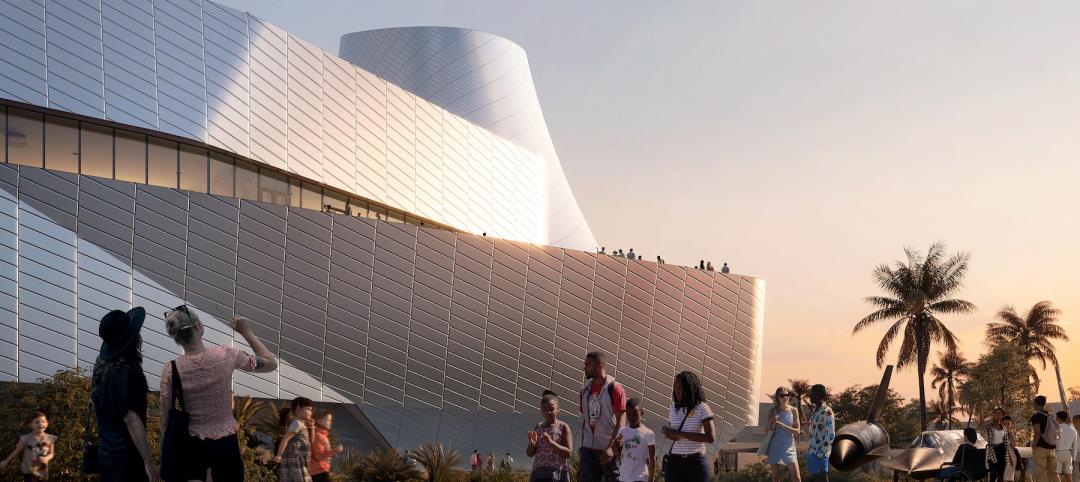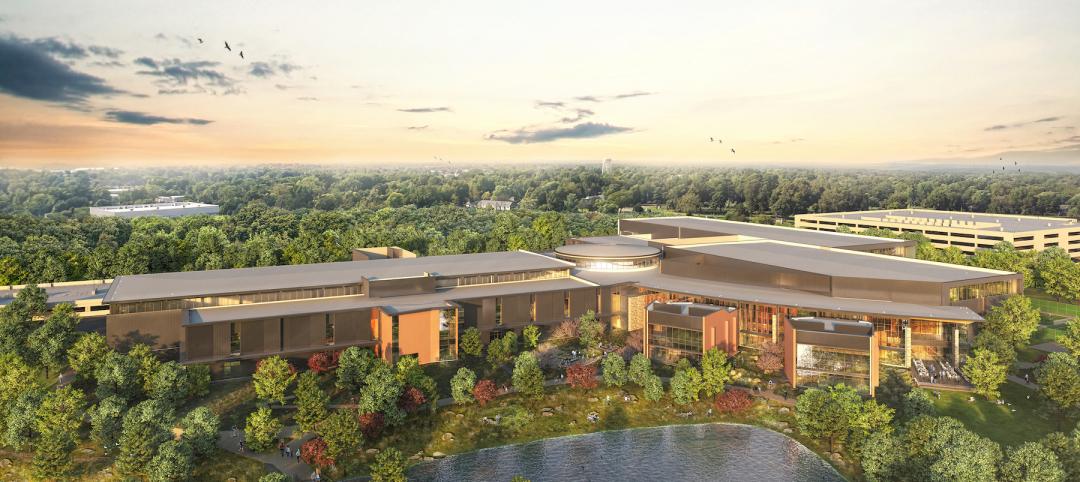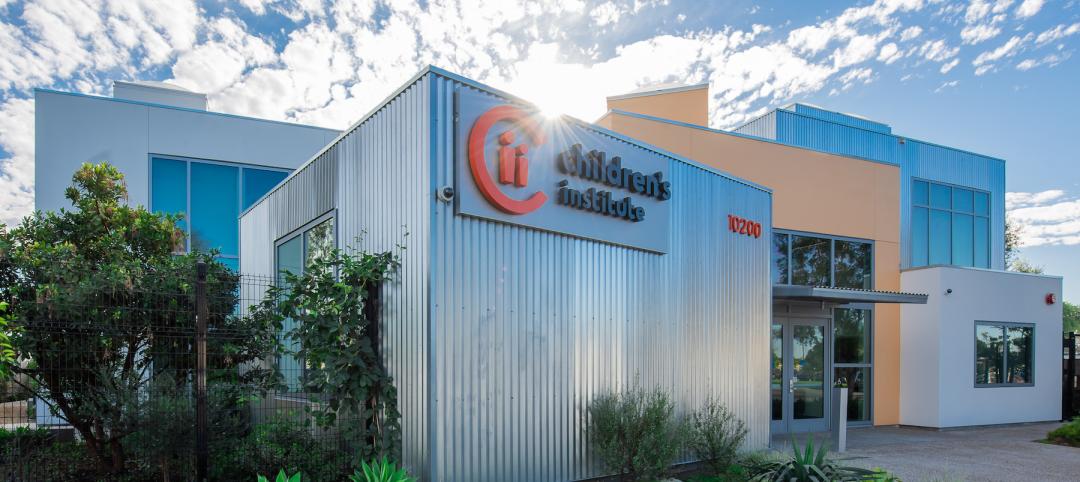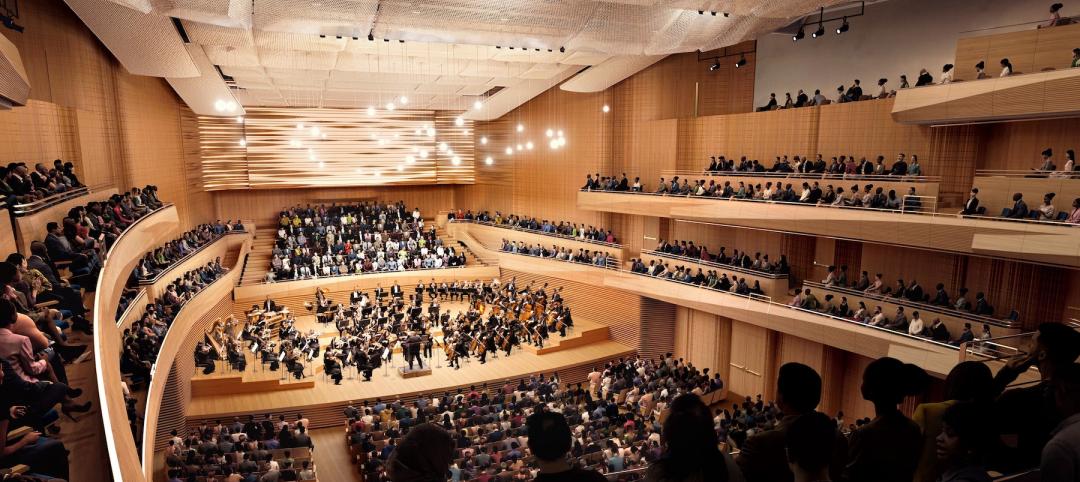 |
| EMPAC is built into a hillside overlooking the Hudson Valley on the RPI campus. Grimshaw’s design was chosen partially because of how it took advantage of the site. |
Rensselaer Polytechnic Institute, the nation's oldest technology university, has long prided itself on its state-of-the-art design and engineering curriculum. Several years ago, to call attention to its equally estimable media and performing arts programs, RPI commissioned British architect Sir Nicholas Grimshaw to design the Curtis R. Priem Experimental Media and Performing Arts Center (EMPAC).
As we recently noted (see “BIM + IPD: 3 Success Stories,” April;), Grimshaw's clever and dramatic “ship-in-a-bottle” structure has become the centerpiece of the Troy, N.Y. campus.
In judging the EMPAC project for the 2009 Building Team Awards, the judges were impressed with the way in which the Building Team addressed the site, a steep hillside overlooking the Hudson Valley. “One of the things that led to our decision to select Grimshaw was that they captured early on how to best take advantage of the site,” said Claude Rounds, the university's VP of administration. “They not only gave an architectural concept of how the structure would fit, but how it would actually complement and enhance the site.” From the early days of the project, RPI wanted a Building Team that would make the most effective use of the difficult site conditions.
 |
| The walls of EMPAC’s two studios are composed of adjustable acoustic diffusion panels painted matte black to allow an acoustic con• guration for any performance. Studio 1 (above) is capable of audio presentation but is optimized for dance, visualization, multi-screen, and immersive performances. PHOTO: TURNER CONSTRUCTION CO |
In 2004, RPI turned to the integrated project delivery team at the nation's largest construction firm, Turner Construction Co., to fulfill Grimshaw's vision. The project's original construction manager had parted ways with Rensselaer earlier that year due to constructability issues. Turner assembled a blue-ribbon team: Architectural Woodwork Industries, Philadelphia (custom woodwork), Supermetals Structures, Quebec (structural steel design), Radius Track of Minnesota (steel fabrication), Gartner (curtain wall), Davis Brody Bond (architect of record), Buro Happold (structural and mechanical engineering systems), GeoTech (site engineers), Fisher Dachs Associates (theater consultant), and Kirkegaard Associates (acoustician).
“We only asked for proposals from people who would come to it in a collaborative fashion,” said Stephen Coates, project manager for Turner. Language was written into the IPD contract documents to make it clear that all participants were responsible for participating in an iterative design process, according to Coates. RPI also demanded the highest standards of performance and acoustics in the statement of program and design intent.
An intense, four-month design process followed the selection of the Building Team members. At Grimshaw's suggestion everyone used Rhinoceros, a 3D design application that allowed the team to model and test the curved surfaces of EMPAC. The team was literally passing new models back and forth to each other on a daily basis. Grimshaw's computational design director, Shane Burger, said using Rhino as a common design tool helped achieve not only a common aesthetic goal, but also a common technical and construction goal.
 |
| Because of the difficult site, EMPAC was built into the hillside site in staggered steps. The performance spaces were acoustically isolated on one side of the building with lobbies and offices on the other side. PHOTO: TURNER CONSTRUCTION CO. |
The initial design went through three major conceptual changes during this process. In the end, the team found a way to deliver four primary performance spaces and all the office space that the university needed, each in an isolated portion of the building, while still staying honest to Grimshaw's aesthetic vision.
Instead of fighting against the site, the final design took advantage of it, maximizing views for patrons with glass curtain wall on all sides. By building the structure into the hill, the design used all the space available to create an unmistakable focus for the RPI campus.
The collaboration continued into the construction process. Gartner supervised installation of EMPAC's north curtain wall and created a rules system in the model for installation of the custom panels in the performance spaces; this consisted of a collection of custom panels of varying depth. For audience comfort, each seat in the theater has an air supply below it. Buro Happold created a computational fluid dynamics analysis for each seating design change.
 |
| Major structural elements of EMPAC include lagged shoring walls, caissons, mini-piles, pile caps and grade beams, a concrete superstructure (top), steel framing, and composite decks. Turner Construction Company delivered the complex design on time and on budget. |
Every interior space is connected through fiber-optic cables to a supercomputer on campus—at RPI, computing is intrinsically related to delivering the performing arts. “The space had to be tunable, just as you'd tune an instrument,” said Burger.
Theater consultant Fisher Dachs Associates and acoustician Kirkegaard Associates worked closely with the design team to deliver EMPAC's dramatic 1,200-seat theater space. The ceiling consists of panels of Nomex-brand heat- and fire-resistant fabric, each less than one millimeter thick, supported on a web of stainless-steel cables.
Nomex was selected for its ability to gently reflect high-frequency sound while remaining transparent to mid- and low-frequency sound. This combination of attributes provides acoustic support to the musicians on the platform while allowing the volume above the ceiling to contribute to the reverberance expected of a first-rate orchestral hall.
The fabric ceiling, like the walls, is gently convex in shape and masks the electrical and mechanical equipment and light fixtures situated above. An aural study of the acoustic design was done before construction to verify its feasibility. “It was the intense focus on creating a world-class venue for acoustics that we felt set [the project] apart,” said Grimshaw supervising partner Mark Husser.
In bestowing its only Platinum Award this year on EMPAC, BD+C's Building Team Awards jury praised both its design and construction excellence. “The acoustical features are incorporated into the design instead of being tacked on during construction,” said Tracy Nicholas, VP, Alter Construction Management, Skokie, Ill. “They used BIM and fully integrated project delivery to the fullest extent to deliver a great project.”
“The project had to do something beyond ordinary, and this does it,” said Carol Ross Barney, FAIA, of Chicago's Ross Barney + Jankowski, designer of the Oklahoma City Federal Building and many university projects. “It's an example of aesthetics and technology done together very well. It makes me think about acoustics in a whole new way.”
Related Stories
Giants 400 | Aug 20, 2022
Top 180 Architecture Firms for 2022
Gensler, Perkins and Will, HKS, and Perkins Eastman top the rankings of the nation's largest architecture firms for nonresidential and multifamily buildings work, as reported in Building Design+Construction's 2022 Giants 400 Report.
Giants 400 | Aug 19, 2022
2022 Giants 400 Report: Tracking the nation's largest architecture, engineering, and construction firms
Now 46 years running, Building Design+Construction's 2022 Giants 400 Report rankings the largest architecture, engineering, and construction firms in the U.S. This year a record 519 AEC firms participated in BD+C's Giants 400 report. The final report includes more than 130 rankings across 25 building sectors and specialty categories.
Cultural Facilities | Aug 5, 2022
A time and a place: Telling American stories through architecture
As the United States enters the year 2026, it will commence celebrating a cycle of Sestercentennials, or 250th anniversaries, of historic and cultural events across the land.
Museums | Jun 28, 2022
The California Science Center breaks grounds on its Air and Space Center
The California Science Center—a hands-on science center in Los Angeles—recently broke ground on its Samuel Oschin Air and Space Center.
Headquarters | Jun 21, 2022
Walmart combines fitness and wellness in associates’ center that’s part of its new Home Office plan
Duda | Paine’s design leads visitors on a “journey.”
Cultural Facilities | Jun 15, 2022
Gehry-designed Children’s Institute aims to foster community outreach in L.A.’s Watts neighborhood
The Children’s Institute (CII) in Los Angeles will open a 200,000-sf campus designed by Frank Gehry this summer.
Cultural Facilities | Jun 10, 2022
After 10 Years, Taiwan’s new Taipei Music Center Reaches the Finish Line
RUR Architecture has finished the Taipei Music Center (TMC), turning a 22-acre (9-hectare) site into a new urban arts district.
Projects | Mar 24, 2022
A Hollywood home for creatives
A Hollywood development will serve as a collaborative center for artists, students, and those in the entertainment industry.
Cultural Facilities | Mar 10, 2022
A ‘reimagined’ David Geffen Hall in New York is on track to open this fall
Its half-billion-dollar reconstruction is positioning this performance space as an integral key to luring people to the city again.
Performing Arts Centers | Mar 8, 2022
Cincinnati Ballet’s new center embodies the idea that dance is for everyone
Cincinnati Ballet had become a victim of its own success, according to company president and CEO Scott Altman. “We were bursting at the seams in our old building. We had simply outgrown the facility,” Altman told the Cincinnati Enquirer.
















